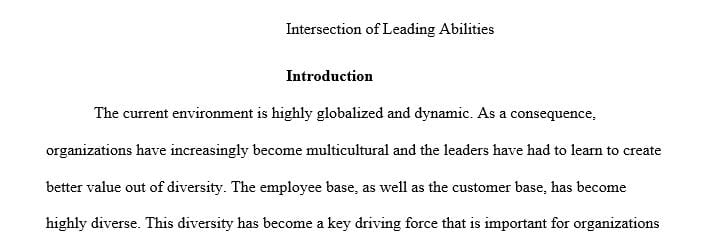Should a change in demographics necessitate a change in leadership style
WK1 Of Leadership And Diversity
After completing the assigned reading and conducting additional research on leadership, diversity and trends with respect to changing demographics in education, write a 1320-1650 word paper addressing the following questions:
What type of challenges might a leader have if he or she does not consider diversity (specifically related to the race, ethnicity, culture, gender, age, etc.) when making decisions?
Do all decisions need to be made with diversity in mind? Justify your answer.
Should a change in demographics necessitate a change in leadership style?
This assignment is worth 8 points of the total course grade.
This assignment aligns with the following weekly outcomes: 1,2,3,4
This assignment aligns with the following course outcomes: 1,3,4
Resources
Required Text
Connerley, M. (2005). Leadership in a diverse and multicultural environment: Developing awareness, knowledge, and skills. Thousand Oaks: Sage Publications.
Chapter 1: Making the Business Case for Increased Awareness, Knowledge and Skills
Chapter 2: The Complexity of Culture
Required References
Goleman, D. (2004). What makes a leader? Harvard Business Review, 82(1), 82-91.
Hayashi, C. A., & Fisher-Adams, G. (2015). Strengthening Leadership Preparation to Meet the Challenge of Leading for Learning in the Digital Age: Recommendations from Alumni. Educational Leadership and Administration: Teaching and Program Development, 26, 51-67.
Hofmeyer, A., Sheingold, B. H., Klopper, H. C., & Warland, J. (2015). Leadership In Learning And Teaching In Higher Education: Perspectives Of Academics In Non-Formal Leadership Roles. Contemporary Issues in Education Research (CIER), 8(3), 181-192.
Kezar, A., Lester, J., Carducci, R., Gallant, T. B., & McGavin, M. C. (2007). Where Are the Faculty Leaders?: Strategies and Advice for Reversing Current Trends. Liberal Education, 93(4), 14-21. Retrieved from http://files.eric.ed.gov/fulltext/EJ790433.pdf
Lord, R. G., & Emrich, C. G. (2001). Thinking outside the box by looking inside the box: Extending the cognitive revolution in leadership research. The Leadership Quarterly, 11(4), 551-579. Retrieved from https://www.researchgate.net/profile/Cynthia_Emric…
Prescott, B. (2012, October 22). What demographic changes mean for colleges and counselors. Chronicle of Higher Education. Retrieved from http://chronicle.com/blogs/headcount/what-demograp…
Recommended References
U.S. Department of Education. (n.d.). National Center for Educational Statistics. http://nces.ed.gov/
Week 1 Assignment Intersections Of Leadership And Diversity
Course Learning OutcomesUpon successful completion of this course, you will be able to:1.Demonstrate an understanding of diversity2.Evaluate leadership models, frameworks and/or theories.3.Examine leadership issues in educational settings as they relate to serving a diverse student population.4.Analyze the implications of diversity on learning, pedagogy and leadership.5.Apply current research in the field to present leadership challenges in higher education settings.6.Formulate best practices for leading that incorporate an understanding of diversity.7.Develop strategies to institutionalize leadership practices for diverse populations.Mission Statement: University of the Rockies provides high-quality, accessible learning opportunities globally for diverse groups of individuals seeking preparation for life goals, professional practice, service, and distinguished leadership.
Required ResourcesRequired TextsConnerley, M. (2005). Leadership in a diverse and multicultural environment: Developing awareness, knowledge, and skills. Thousand Oaks: Sage Publications. ISBN-13 – 9780761988601; eISBN – 9781452208770..Required ArticlesAyman, R. (2010). Leadership: Why gender and culture matter. American Psychologist, 65(3), Special issue: Diversity and Leadership, 157-170.Chin, J. (2010). Introduction to the special issue on diversity and leadership. American Psychologist, 65(3), Special issue: Diversity and Leadership, 150-156.Clayton, J. K. (2014). The Leadership Lens: Perspectives on Leadership from School District Personnel and University Faculty. International Journal of Educational Leadership Preparation, 9(1), n1.DeZure, D., Shaw, A., & Rojewski, J. (2014). Cultivating the next generation of academic leaders: Implications for administrators and faculty. Change: The Magazine of Higher Learning, 46(1), 6-12.Dingel, M., & Wei, W. (2014). Influences on peer evaluation in a group project: an exploration of leadership, demographics and course performance. Assessment & Evaluation in Higher Education, 39(6), 729-742.Gholamzadeh, D., & Ravana, E. (2016). Transactional model: A comprehensive framework for leadership process understanding. International Journal of Humanities and Cultural Studies (IJHCS) ISSN 2356-5926, 1(1), 1168- 1208. Retrieved from http://www.ijhcs.com/index.php/ijhcs/article/viewF…Goleman, D. (2004). What makes a leader? Harvard Business Review, 82(1), 82-91.Hayashi, C. A., & Fisher-Adams, G. (2015). Strengthening Leadership Preparation to Meet the Challenge of Leading for Learning in the Digital Age: Recommendations from Alumni. Educational Leadership and Administration: Teaching and Program Development, 26, 51-67.Hofmeyer, A., Sheingold, B. H., Klopper, H. C., & Warland, J. (2015). Leadership In Learning And Teaching In Higher Education: Perspectives Of Academics In Non-Formal Leadership Roles. Contemporary Issues in Education Research (CIER), 8(3), 181-192.Hytten, K. (2011). Understanding education for social justice. Journal of Educational Foundations, 25(1/2), 7-24.Hu-DeHart, E. (2000). The diversity project: Institutionalizing multiculturalism or managing differences? Academe, 86(5), 38-42.Jones, S. (2014, May). Distributed leadership: A critical analysis. Leadership, 10(2), 129-141. doi: 10.1177/1742715011433525 Kezar, A. (2007). Tools for a time and place: Phased leadership strategies to institutionalize a diversity agenda. Review of Higher Education, 30(4), 413-439.Kezar, A., Lester, J., Carducci, R., Gallant, T. B., & McGavin, M. C. (2007). Where Are the Faculty Leaders?: Strategies and Advice for Reversing Current Trends. Liberal Education, 93(4), 14-21. Retrieved fromhttp://files.eric.ed.gov/fulltext/EJ790433.pdfKnight, J. (2015). New rationales driving internationalization. International Higher Education, (34). Retrieved from https://ejournals.bc.edu/ojs/index.php/ihe/article…Lawson, H. A. (2014). Investing in Leaders and Leadership to Secure a Desirable Future. Quest, 66(3), 263-287.Lord, R. G., & Emrich, C. G. (2001). Thinking outside the box by looking inside the box: Extending the cognitive revolution in leadership research. The Leadership Quarterly, 11(4), 551-579. Retrieved from https://www.researchgate.net/profile/Cynthia_Emrich/public…ooking_inside_the_box_Extending_the_cognitive_revolution_in_leadership_research/links/54258bc10cf238c6e a741a97.pdf Mittal, R. (2015). Charismatic and transformational leadership styles: A cross-cultural perspective. International Journal of Business and Management, 10(3), 26. Retrieved fromhttp://www.ccsenet.org/journal/index.php/ijbm/arti…
Answer preview to should a change in demographics necessitate a change in leadership style
APA
1560 words



